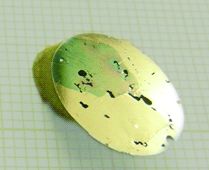Compared to the first families of iron-based superconductors, the FeSe
1-xTe
x systems do not have extremely high superconducting transition temperatures, but they do crystallise in relatively simple crystal structures. We have grown large single crystals of FeSe
0.48Te
0.52 with a critical temperature Tc = 14K (see figure, left-hand side).
In collaboration with the national high magnetic field laboratory in Grenoble and Toulouse, we have obtained for the first time total dependence of the critical field H
c2over the whole temperature range. H
c2 being close to 50 teslas at low temperature, we had to have recourse to pulsed fields. Our measurements show, among other results, that contrary to what we might expect the anisotropy of the critical field, with respect to the orientation of the field relative to the crystalline axes, is relatively small. Yet, similar to the first HTCS with copper-oxygen planes, the new iron compounds have a very anisotropic structure (see figure, right-hand side), and this two-dimensional characteristic has often been mentioned as essential in order to explain the striking properties of the HTCSs. A new challenge!.
 FeSe0.48Te0.52 monocrystal.
FeSe0.48Te0.52 monocrystal.